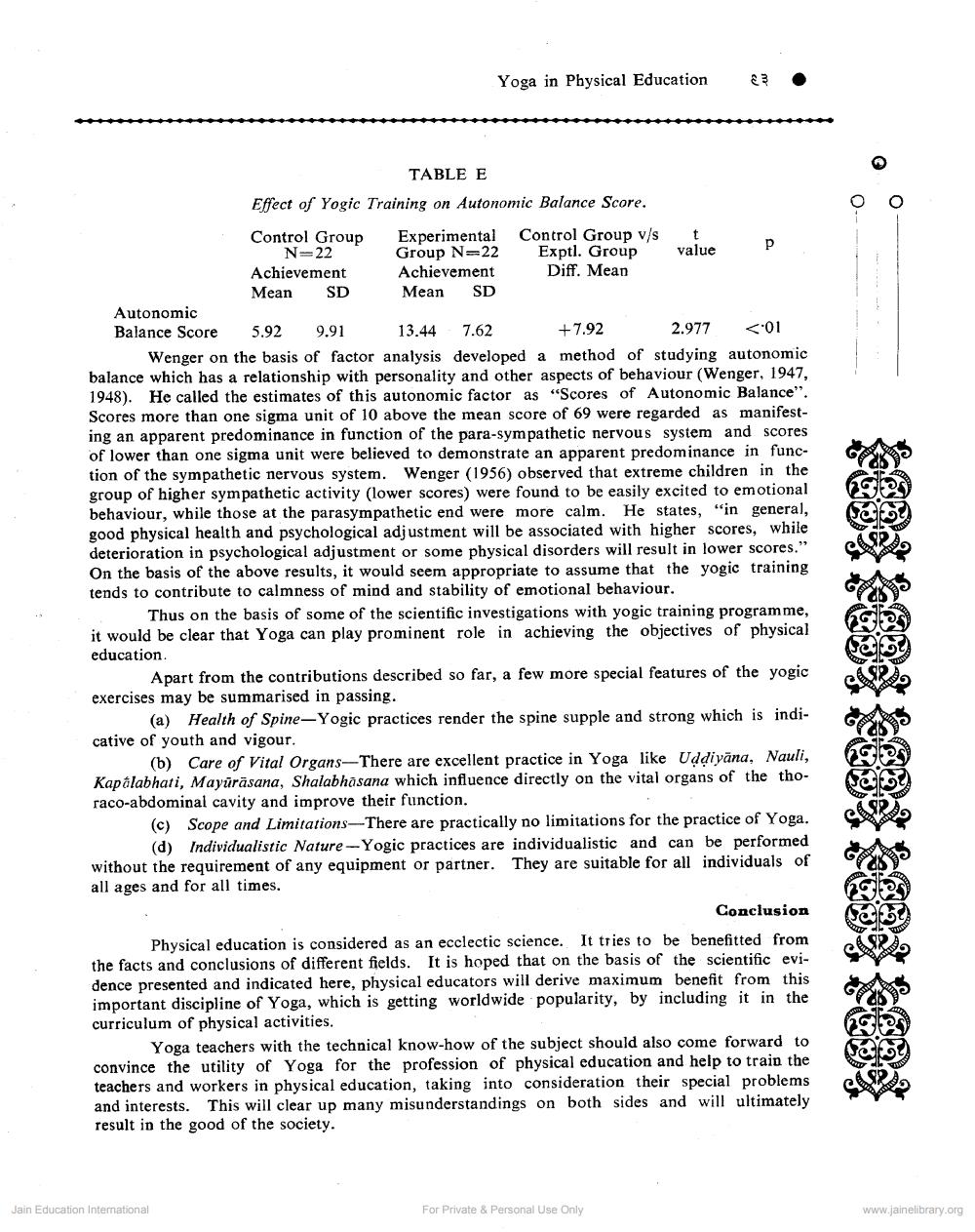Book Title: Yoga in Physical Education Author(s): M L Gharote Publisher: Z_Pushkarmuni_Abhinandan_Granth_012012.pdf View full book textPage 6
________________ Yoga in Physical Education 23 • TABLE E Effect of Yogic Training on Autonomic Balance Score. Control Group Experimental Control Group v/ s t N-22 Group N=22 Exptl. Group value Achievement Achievement Diff. Mean Mean SD Mean SD Autonomic Balance Score 5.929.91 13.44 7.62 +7.92 2.977 <:01 Wenger on the basis of factor analysis developed a method of studying autonomic balance which has a relationship with personality and other aspects of behaviour (Wenger, 1947, 1948). He called the estimates of this autonomic factor as “Scores of Autonomic Balance". Scores more than one sigma unit of 10 above the mean score of 69 were regarded as manifesting an apparent predominance in function of the para-sympathetic nervous system and scores of lower than one sigma unit were believed to demonstrate an apparent predominance in function of the sympathetic nervous system. Wenger (1956) observed that extreme children in the group of higher sympathetic activity (lower scores) were found to be easily excited to emotional behaviour, while those at the parasympathetic end were more calm. He states, “in general, good physical health and psychological adjustment will be associated with higher scores, while deterioration in psychological adjustment or some physical disorders will result in lower scores." On the basis of the above results, it would seem appropriate to assume that the yogic training tends to contribute to calmness of mind and stability of emotional behaviour. Thus on the basis of some of the scientific investigations with yogic training programme, it would be clear that Yoga can play prominent role in achieving the objectives of physical education Apart from the contributions described so far, a few more special features of the yogic exercises may be summarised in passing. (a) Health of Spine-Yogic practices render the spine supple and strong which is indicative of youth and vigour. (b) Care of Vital Organs-There are excellent practice in Yoga like Uddiyāna, Nauli, Kapalabhati, Mayūrāsana, Shalabhasana which influence directly on the vital organs of the thoraco-abdominal cavity and improve their function. (c) Scope and Limitations-There are practically no limitations for the practice of Yoga. (d) Individualistic Nature --Yogic practices are individualistic and can be performed without the requirement of any equipment or partner. They are suitable for all individuals of all ages and for all times. Conclusion Physical education is considered as an ecclectic science. It tries to be benefitted from the facts and conclusions of different fields. It is hoped that on the basis of the scientific evidence presented and indicated here, physical educators will derive maximum benefit from this important discipline of Yoga, which is getting worldwide popularity, by including it in the curriculum of physical activities. Yoga teachers with the technical know-how of the subject should also come forward to convince the utility of Yoga for the profession of physical education and help to train the teachers and workers in physical education, taking into consideration their special problems and interests. This will clear up many misunderstandings on both sides and will ultimately result in the good of the society. Jain Education International For Private & Personal Use Only www.jainelibrary.orgPage Navigation
1 ... 4 5 6 7 8
